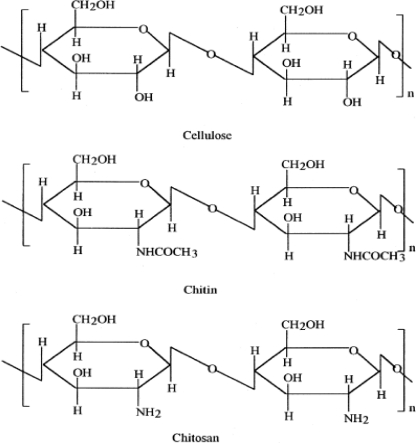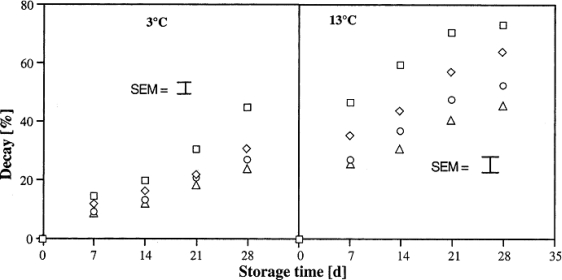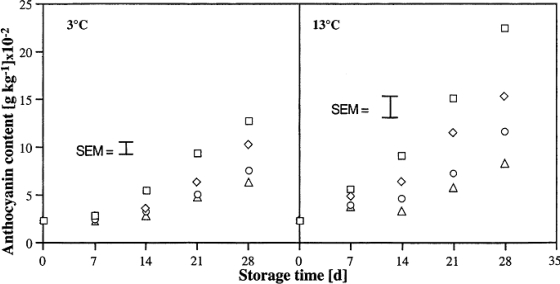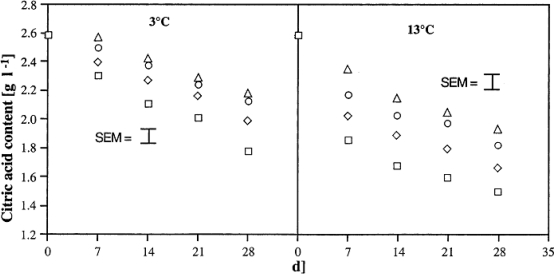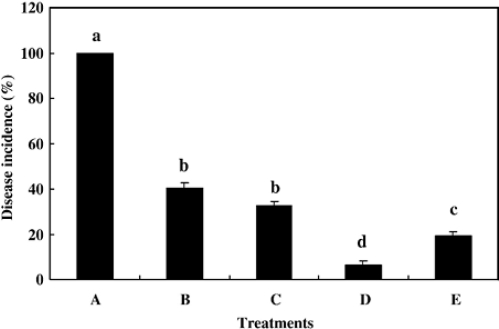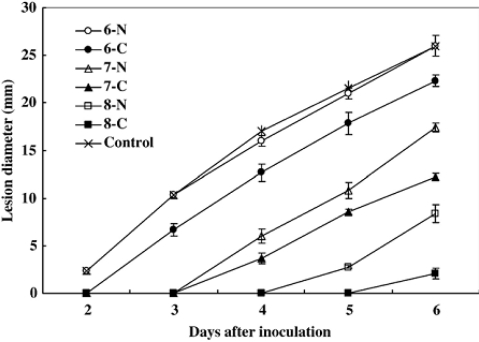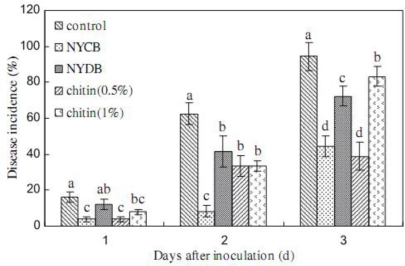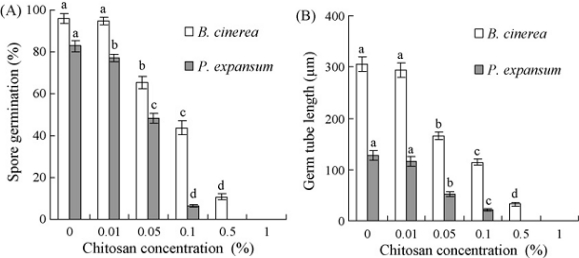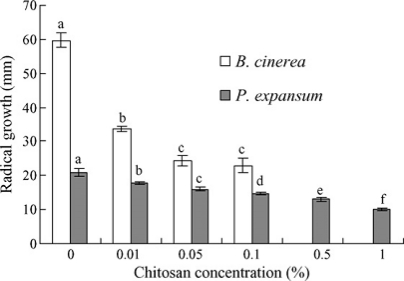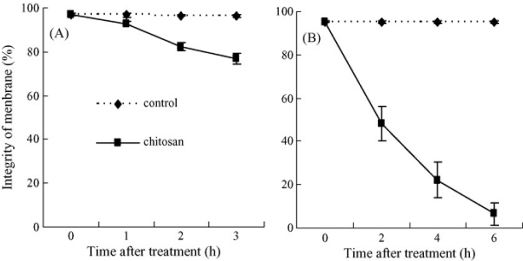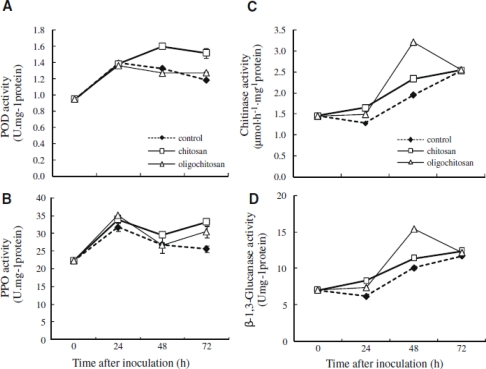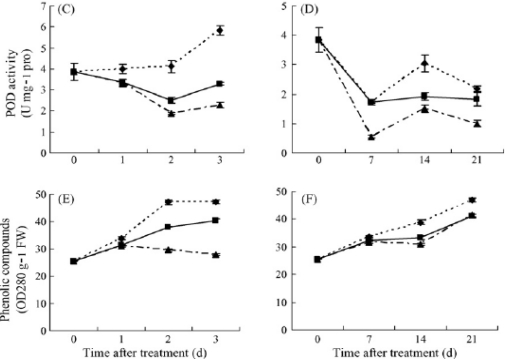Abstract
Considerable economic losses to harvested fruits are caused by postharvest fungal decay during transportation and storage, which can be significantly controlled by synthetic fungicides. However, considering public concern over pesticide residues in food and the environment, there is a need for safer alternatives for the control of postharvest decay to substitute synthetic fungicides. As the second most abundant biopolymer renewable source in nature, chitin and its derivative chitosan are widely used in controlling postharvest decay of fruits. This review aims to introduce the effect of chitin and chitosan on postharvest decay in fruits and the possible modes of action involved. We found most of the actions discussed in these researches rest on physiological mechanisms. All of the mechanisms are summarized to lay the groundwork for further studies which should focus on the molecular mechanisms of chitin and chitosan in controlling postharvest decay of fruits.
Keywords: chitin, chitosan, fruits, postharvest decay, control efficacy, mechanisms
1. Introduction
Fresh fruits and vegetables are very perishable and susceptible to postharvest diseases which limit the storage period and marketing life of them. Moreover, postharvest decay results in substantial economic losses around the world. As is known, synthetic fungicide treatment has long been the main method for controlling postharvest diseases [1]. However, there is increasing international concern over the indiscriminate use of synthetic fungicides on crops because of the possible harmful effects on human health [2] and the emergence of pathogen resistance to fungicides [3]. Therefore, new alternatives for controlling postharvest diseases which have good efficacy, low residues, and little or no toxicity to non-target organisms are in urgent demand.
A great many alternative strategies, including biological control with antagonistic microorganisms, applications of plant bioactive compounds, refrigerated storage, heat treatment, high pressure processing and modified atmosphere storage [4,5], have been used to control postharvest diseases of fruits and inhibit growth of the pathogens. However, all these methods could not control postharvest diseases as effectively as synthetic fungicides. And some of the processes also have limitations, such as partial destruction of quality attributes of food products, especially heat-labile nutrients and sensory attributes [6].
Chitin, together with its derivative chitosan, has been reported as a promising alternative to control postharvest diseases. Chitin is the second most abundant biopolymer renewable source in nature after cellulose, which has a versatile application potential in the agriculture-food industry [7], for instance, as a biopesticide, which has been approved by the U.S. Environmental Protection Agency (EPA), and as a food additive, approved by the U.S. Food and Drug Administration (FDA). Similarly, chitosan has become a prospective alternative treatment for fruit and vegetables due to its natural character, antimicrobial activity, and elicitation of defense responses in plant tissue [8,9]. Chitin or chitosan has been used to control postharvest diseases of many fruits such as pear [10], strawberry [11,12], table grape [13], tomato [14], citrus [15], and longan [16].
This review summarizes the efficiency of chitin and chitosan on controlling postharvest diseases which consequently prolongs the shelf-life of fruits, and its possible mechanisms involved. New research approaches to fully understand the mechanism of chitin and chitosan against fungal pathogens are also suggested.
2. Structures and Functions of Chitin and Chitosan
Chitin and chitosan are polysaccharides, chemically similar to cellulose, differing only by the presence or absence of nitrogen [17]. Chitin, a naturally abundant mucopolysaccharide, and the supporting material of crustaceans, insects, etc., is well known to consist of 2-acetamido-2-deoxy-β-d-glucose though a β (1→4) linkage. Chitin can be degraded by chitinase. Its immunogenicity is exceptionally low, in spite of the presence of nitrogen. It is a highly insoluble material resembling cellulose in its solubility and low chemical reactivity. It may be regarded as cellulose with hydroxyl at position C-2 replaced by an acetamido group. Like cellulose, it functions naturally as a structural polysaccharide. Chitin is a white, hard, inelastic, nitrogenous polysaccharide and the major source of surface pollution in coastal areas. Chitosan is the N-deacetylated derivative of chitin, although this N-deacetylation is almost never complete. A sharp nomenclature with respect to the degree of N-deacetylation has not been defined between chitin and chitosan [18,19]. The structures of cellulose, chitin and chitosan are shown in Figure 1 [20].
Figure 1.
Structures of cellulose, chitin and chitosan. Reproduced from Reference [20].
Chitin and its derivative chitosan have been of interest in the past few decades due to their potential broad range of industrial applications [21,22]. However, there has been limited attention paid to the food application of these versatile biopolymers. They offer a wide range of unique applications including bioconversion for the production of value-added food products [23–25], preservation of foods from microbial deterioration [26–30], formation of biodegradable films [31–36], recovery of waste material from food processing discards [37–44], purification of water [45–48] and clarification and deacidification of fruit juices [49–53]. In this text, we especially pay attention to the antimicrobial function of chitin and chitosan in fruits. Hernández-Lauzardo et al. have reported the significant effect of chitosan on inhibiting three isolates of Rhizopus stolonifer obtained from several fruits [54]. It has been reported that chitin and chitosan are effective in reducing postharvest diseases of fruits and vegetables by inhibiting spore germination, germ tube elongation, mycelial growth of fungal phytopathogens, enhancing the efficacy of antagonistic yeasts, and boosting the activity of defense-related enzymes or pertinent substances [55–60].
3. Effects of Chitin and Chitosan on Postharvest Disease of Fruits
Recently, the method of using chitin and chitosan to control postharvest diseases of fruits was developed. Chitosan at low molecular weight (LMWC) has been reported to control postharvest diseases of citrus fruit [15]. The results indicated that LMWC significantly inhibited the decay of citrus fruit caused by Penicillium digitatum, Penicillium italicum, Botrydiplodia lecanidion, and Botrytis cinerea after 14 days storage at 25 °C, and is more effective than TBZ and high molecular weight chitosan (HMWC) (Table 1). Meanwhile, low molecular weight chitosan coating beneficially influenced firmness, total soluble solid content, titratable acidity, ascorbic acid content and water content of citrus fruit after 56 days of storage at 15 °C (Table 2). Bhaskara Reddy et al. [12] found that pre-harvest chitosan sprays effectively inhibited the postharvest decay of strawberry fruit caused by Botrytis cinerea during storage at 3 and 13 °C, and the decay decreased with increasing chitosan concentration (Figure 2). Furthermore, fruits from chitosan sprayed plants were firmer and ripened at a slower rate as indicated by anthocyanin content and titratable acidity than berries from non-treated plants (Figures 3 and 4).
Table 1.
Effect of low molecular weight chitosan (LMWC) on decay of citrus fruits caused by Penicillium digitatum, Penicillium italicum, Botrydiplodia lecanidion and Botrytis cinerea. Reproduced from Reference [15].
| Treatments1 |
Infected Fruit (%)2,3 |
|||
|---|---|---|---|---|
| P. digitatum | P. Italicum | B. Lecanidion | B. cinerea | |
| Control | 100 a | 100 a | 100 a | 100 a |
| HMWC | ||||
| 0.05% | 60.0 c | 65.0 c | 78.3 c | 70.0 c |
| 0.1% | 53.3 d | 66.7 c | 75.0 c | 68.3 c |
| 0.2% | 41.7 e | 58.3 d | 73.3 c | 60.0 d |
| LMWC | ||||
| 0.05% | 21.7 f | 25.0 e | 33.3 d | 30.0 e |
| 0.1% | 10.0 g | 15.3 f | 21.6 e | 18.3 f |
| 0.2% | 5.0 h | 8.3 g | 15.0 f | 11.7 g |
| TBZ | ||||
| 0.1% | 78.3 b | 83.3 b | 88.3 b | 85.0 b |
The P. digitatum, P. italicum, B. lecanidion and B. cinerea spore concentrations were 105 conidia/mL;
Means are averaged over three trials. Each trial involved treating three identical groups of 120 citrus fruit with each treatment. Decay was evaluated after 14 days of storage at 25 °C;
Values followed by the same letter do not significantly differ at P > 0.05, according to Duncan’s multiple range test.
Table 2.
Effect of low molecular weight chitosan (LMWC) coating on quality attributes of postharvest Murcott tangor fruits after 56 days of storage at 15 °C 1,2. Reproduced from Reference [15].
| Firmness (g) | Total Soluble Solids (brix) | Titratable Acidity (%) | Ascorbic Acid (mg/100 mL) | Water Contents (%) | |
|---|---|---|---|---|---|
| Control (water) | 136 ± 5 d | 12.9 ± 0.5 b | 1.12 ± 0.03 b | 52.2 ± 2.3 c | 80.7 ± 1.2 e |
| LMWC | |||||
| 0.05% | 223 ± 5 c | 13.8 ± 0.1 a | 1.25 ± 0.04 a | 75.1 ± 2.9 a | 84.1 ± 1.9 c |
| 0.1% | 248 ± 5 b | 13.8 ± 0.2 a | 1.27 ± 0.05 a | 75.3 ± 3.1 a | 86.4 ± 1.2 b |
| 0.2% | 269 ± 5 a | 13.9 ± 0.1 a | 1.28 ± 0.05 a | 75.5 ± 3.1 a | 87.8 ± 2.3 a |
| HMWC | |||||
| 0.05% | 196 ± 4 e | 13.1 ± 0.1 b | 1.11 ± 0.05 b | 63.2 ± 2.9 b | 83.7 ± 2.0 d |
| 0.1% | 198 ± 4 e | 13.1 ± 0.1 b | 1.12 ± 0.04 b | 63.5 ± 3.0 b | 83.8 ± 1.2 d |
| 0.2% | 200 ± 5 e | 13.2 ± 0.1 b | 1.12 ± 0.05 b | 64.1 ± 3.0 b | 83.9 ± 2.0 d |
| TBZ | |||||
| 0.1% | 193 ± 5 e | 13.1 ± 0.1 b | 1.12 ± 0.05 b | 62.7 ± 3.1 b | 83.5 ± 2.2 d |
Means are averaged values of three trials. Each trial contained three replicates of 120 Murcott tangor fruits per treatment.
Values within a column with the same letter are not significantly different (P > 0.05).
Figure 2.
Effect of pre-harvest chitosan spray treatments on the decay of strawberry fruit stored at 3 (S.E.M. ± 1.58) and 13 °C (S.E.M. ± 2.28). Control (□); 2 gl−1 (⋄); 4 gl−1 (○) and 6 gl−1 (Δ). Data were pooled across the number of sprays and picks and repetitions. Reproduced from Reference [12].
Figure 3.
Effect of pre-harvest chitosan spray treatments on anthocyanin content of strawberry fruit stored at 3 (S.E.M. ± 0.57 × 10−2) and 13 °C (S.E.M. ± 0.84 × 10−2). Control (□); 2 gl−1 (⋄); 4 gl−1(○) and 6 gl−1 (Δ). Data were pooled across the number of sprays and picks and repetitions. Reproduced from Reference [12].
Figure 4.
Effect of pre-harvest chitosan spray treatments on titratable acidity of strawberry fruit stored at 3 (S.E.M. ± 0.038) and 13 °C (S.E.M. ± 0.18); Control (□); 2 gl−1 (⋄); 4 gl−1(○) and 6 gl−1 (Δ). Data were pooled across the number of sprays and picks and repetitions. Reproduced from Reference [12].
In addition to being singularly applied, there are many reports on combined applications of chitosan with other antifungal compounds. Yu et al. [61] found that chitosan applied alone or with Cryptococcus laurentii could effectively inhibit the blue mold rot caused by Penicillium expansum in apple fruit after seven days of incubation at 20 °C. When applied alone, treatment with chitosan at the highest concentration (1%) and the lowest viscosity (12 cP) was the most effective. When used in combinations, treatment of Cryptococcus laurentii with chitosan at a concentration of 0.1% and lowest viscosity (12 cP) was the most effective (Table 3). Similar results were found when using chitosan coating with postharvest calcium on extending shelf-life of strawberries [62]; and chitosan with ethanol on controlling postharvest gray mold of table grapes caused by Botrytis cinerea [63].
Table 3.
Effects of chitosan at different concentrations with various viscosities, alone, or in combination with Cryptococcus laurentii on the reduction of the blue mould rot in apple fruit wounds. Reproduced from Reference [61].
| Treatments | Disease Incidence (%) | Lesion Diameter (mm) | |
|---|---|---|---|
| Control | 100 ± 0 | 17.71 ± 1.69 | |
| 1% chitosan | 12 cP | 39.4 ± 2.5 | 5.20 ± 0.17 |
| 20 cP | 45.9 ± 2.4 | 5.67 ± 0.29 | |
| 100 cP | 51.1 ± 2.0 | 6.97 ± 0.35 | |
| 130 cP | 55.9 ± 1.5 | 6.87 ± 0.35 | |
| 0.1% chitosan | 12 cP | 87.5 ± 3.9 | 12.1 ± 0.32 |
| 20 cP | 100 ± 0 | 13.9 ± 0.31 | |
| 100 cP | 100 ± 0 | 15.3 ± 0.60 | |
| 130 cP | 100 ± 0 | 16.3 ± 0.63 | |
| C. laurentii | 48.4 ± 2.6 | 6.67 ± 0.48 | |
| C. laurentii + 1% chitosan | 12 cP | 30.0 ± 1.3 | 5.52 ± 0.42 |
| 20 cP | 33.8 ± 2.7 | 6.37 ± 0.38 | |
| 100 cP | 44.3 ± 3.2 | 6.93 ± 0.35 | |
| 130 cP | 46.0 ± 3.4 | 7.47 ± 0.50 | |
| C. laurentii + 0.1% chitosan | 12 cP | 14.0 ± 1.2 | 2.37 ± 0.22 |
| 20 cP | 19.3 ± 2.7 | 3.44 ± 0.50 | |
| 100 cP | 33.5 ± 2.2 | 6.07 ± 0.58 | |
| 130 cP | 36.7 ± 1.9 | 6.25 ± 0.35 | |
| C. laurentii + 0.01% chitosan | 12 cP | 45.0 ± 2.7 | 7.7 ± 0.51 |
| 20 cP | 42.5 ± 3.7 | 7.46 ± 0.38 | |
| 100 cP | 52.5 ± 3.1 | 9.46 ± 0.43 | |
| 130 cP | 50.2 ± 3.3 | 8.67 ± 0.29 | |
Data are means ± standard deviations of four replicates.
Biological antagonists have already been shown to effectively inhibit the postharvest decay of fruit in recent years [64–67]. However, for biological control to be accepted as an economically viable option, consistency and efficacy of antagonistic yeasts in controlling postharvest diseases must be enhanced [68,69]. Many attempts have been proposed to improve the performance of postharvest biocontrol yeasts. Physiological manipulation may be a useful method [69]. Recently, enhancement of the biocontrol efficacy of antagonists to postharvest diseases of fruits by addition of chitin or chitosan to the growth medium was reported. Yu et al. [10] found that the disease incidence and lesion diameter of blue mold rot caused by Penicillium expansum in pear fruit was significantly inhibited by Cryptococcus laurentii which was cultivated in nutrient yeast dextrose broth (NYDB) media amended with chitin, especially at the optimal concentration (1.0%) (Figures 5 and 6). Similarly, our research team used Rhodotorula glutinis cultivated with NYDB amended with chitin or nutrient yeast chitin broth (NYCB: Chitin as the sole carbon source instead of dextrose in the media of nutrient yeast dextrose broth) to control the grey mold decay caused by Botrytis cinerea in strawberries [11], we found that the antagonistic activity of R. glutinis was greatly enhanced by chitin inducing incubation (0.5% chitin), which resulted in a significant reduction of the disease incidence (Figure 7).
Figure 5.
Efficacy of Cryptococcus laurentii (1 × 108 cells/mL) in inhibiting disease incidence of blue mold caused by Penicillium expansum in pear fruit wounds after 6 days of incubation at 25 °C in nutrient yeast dextrose broth (NYDB) (B), NYDB amended with chitin at 2.0% (C), 1.0% (D), 0.5% (E). The treatment with water and inoculated with P. expansum was served as the positive control (A). Bars represent standard errors. Different letters indicates significant differences (P = 0.01) according to the Duncan’s multiple range test. Reproduced from Reference [10].
Figure 6.
Efficacy of Cryptococcus laurentii in inhibiting the lesion diameter of blue mold caused by Penicillium expansum in pear fruit wounds at 25 °C. Treatment with water and inoculated with P. expansum was applied as the control. Bars represent standard errors. (○) C. laurentii grown in NYDB at 1 × 106 cells/mL; (•) C. laurentii grown in NYDB with chitin at 1.0% at 1 × 106 cells/mL; (Δ) C. laurentii grown in NYDB at 1 × 107 cells/mL; (▴) C. laurentii grown in NYDB with chitin at 1.0% at 1 × 107 cells/mL; (□) C. laurentii grown in NYDB at 1 × 108 cells/mL; (▪) C. laurentii grown in NYDB with chitin at 1.0% at 1 × 108 cells/mL. Reproduced from Reference [10].
Figure 7.
Efficacy of R. glutinis harvested from different media in controlling grey mould decay of strawberries. Each value is the mean of two experiments. Bars represent standard deviations. Different letters indicate significant differences (P = 0.05) according to Duncan’s multiple range test and the data from each time point are separated. Reproduced from Reference [11].
4. Mode of Action of the Control of Postharvest Decay of Fruits by Chitin and Chitosan
Because of the positive charge on the C2 of the glucosamine monomer below pH 6, chitosan is more soluble and has a better antimicrobial activity than chitin [70]. Therefore, the application on controlling postharvest decay of fruits and the possible mechanisms discussed mostly rest on chitosan. The exact mechanism of the antimicrobial action of chitin, chitosan, and their derivatives is still imperfectly known, but different mechanisms have been proposed [71].
4.1. The Direct Effect of Chitin and Chitosan on Fungal Pathogens
Numerous previous studies have shown that chitosan could directly inhibit spore germination, germ tube elongation and mycelial growth of many phytopathogens, such as Botrytis cinerea [58,59,72], Fusarium solani [73], Rhizopus stolonifer [58,74], Penicillium [59,72], and Sclerotium rolfsii [73]. Liu et al. [59] reported that chitosan completely inhibited spore germination of P. expansum at 0.5% and B. cinerea at 1%, significantly inhibited germ tube elongation of both pathogens when the concentration was higher than 0.01% (P < 0.05) (Figures 8 and 9), and the plasma membranes of spores of both pathogens were damaged (Figure 10). The reasons for the antimicrobial character of chitosan remain controversial. Two hypotheses are as follows: (1) The polycationic chitosan consumes the electronegative charges on cell surfaces and the cell permeability is changed, thus this interaction results in the leakage of intracellular electrolytes and proteinaceous constituents; (2) chitosan enters fungal cells and then essential nutrients are adsorbed, which inhibit or slow down the synthesis of mRNA and protein [75–79].
Figure 8.
Effects of chitosan concentration on spore germination (A) and germ tube elongation (B) of Botrytis cinerea and Penicillium expansum 12 h after incubation at 25 °C. Bars represent standard deviations of the means. Values followed by different letters are significantly different according to Duncan’s multiple range test at P < 0.05. Reproduced from Reference [59].
Figure 9.
Effects of chitosan concentration on mycelial growth of B. cinerea and P. expansum 3 days after incubation at 25 °C. Bars represent standard deviations of the means. Values followed by different letters are significantly different according to Duncan’s multiple range test at P < 0.05. Reproduced from Reference [59].
Figure 10.
Effects of chitosan on plasma membrane integrity of the spores of B. cinerea (A) and P. expansum (B). Pathogen spores were cultured in PDB containing 5% chitosan or in PDB without chitosan as the control at 25 °C. Bars represent standard deviations of the means. Reproduced from Reference [59].
4.2. The Induced Disease Resistance of Fruits by Chitin and Chitosan
The chitinase activity is usually induced in the presence of chitin, which may have diverse biological roles including the antifungal activity [80–82]. As an exogenous elicitor, chitosan can induce resistance in the host by increasing the activities of several defense-related enzymes, such as chitinase and β-1,3-glucanase in oranges, strawberries and raspberries [83,84], and phenylalanine ammonialyase (PAL) activity in strawberries and table grapes [85,86]. Similar results were also found by Meng et al. [87] in pear fruit. After being treated with chitosan or oligochitosan, the activities of POD, PPO, CHI, and β-1,3-GLU in pear fruit were induced which might be beneficial to fruit against infection by fungal pathogens (Figure 11). Liu et al. [88] found that treatment of chitosan induced the activities of PPO and POD, and increased the content of phenolic compounds in tomato fruit stored at 25 and 2 °C (Figure 12); these results possibly being related to the effective control of chitosan on gray mold rot and blue mold rot of tomato fruit. Moreover, chitosan is known to elicit plant defense responses by activating pathogenesis-related (PR) gene functions, such as chitinases [89,90], chitosanase, β-glucanases and lignin [91] and callose [92].
Figure 11.
Effects of chitosan or oligochitosan on activities of POD (A), PPO (B), CHI (C) and β-1,3-glucanase (D) of pear fruit. Reproduced from Reference [87].
Figure 12.
Changes of PPO activities (A and B), POD activities (C and D), and phenolic compounds (E and F) in tomato fruit. Fruit were treated with 1% chitosan, and stored at 25 °C (A, C and E) and 2 °C (B, D and F), respectively. Fruit wounded and treated with water, and non-wounded, served as controls. Bars represent standard deviations of the means. Reproduced from Reference [88].
5. Conclusions
In conlusion, chitin and its derivative chitosan have shown a great potential as natural biodegradable substances which have anti-microbial activities. Previous studies have indicated that chitin and chitosan could effectively inhibit postharvest diseases of fruits by direct inhibition on spore germination, germ tube elongation and mycelial growth of phytopathogens and indirect inducement of defense-related enzymes, such as POD, PPO, PAL, GLU. However, the mode of action for chitin and chitosan controlling postharvest diseases of fruits are still limited and unclear. Therefore, to fully understand the mechanism of chitin and chitosan against fungal pathogens and the function in inducing defense response of fruits to pathogen infection, new approaches at the molecular and proteomic level, including the separation and identification of differential expression genes and differential expression proteins, are really needed in further studies.
References
- 1.Eckert JW, Ogawa JM. The chemical control of postharvest diseases: deciduous fruits, berries, vegetables and root/tuber crops. Annu. Rev. Phytopathol. 1998;26:433–469. [Google Scholar]
- 2.Norman C. EPA sets new policy on pesticide cancer risks. Science. 1998;242:366–367. doi: 10.1126/science.3175656. [DOI] [PubMed] [Google Scholar]
- 3.Holmes GJ, Eckert JW. Sensitivity of Penicillium digitatum and P. italicum to postharvest citrus fungicides in California. Phytopathology. 1999;89:716–721. doi: 10.1094/PHYTO.1999.89.9.716. [DOI] [PubMed] [Google Scholar]
- 4.Sharma RR, Singh D, Singh R. Biological control of postharvest diseases of fruits and vegetables by microbial antagonists: A review. Biol. Control. 2009;50:205–221. [Google Scholar]
- 5.Mari M, Neri F, Bertolini P. Novel approaches to prevent and control postharvest diseases of fruits. Stewart Postharvest Rev. 2007;3:1–7. [Google Scholar]
- 6.Barbosa-Cánovas GV, Davidson PM, Dreher M, Hartel RW. Microwave pasteurization and sterilization of foods. In: Rahman MS, editor. Handbook of Food Preservation. 2nd ed. CRC Press LLC; New York, NY, USA: 2007. pp. 691–711. [Google Scholar]
- 7.Prashanth KVH, Tharanathan RN. Chitin/chitosan: Modifications and their unlimited application potential—An overview. Trends Food Sci. Technol. 2007;18:117–131. [Google Scholar]
- 8.Terry LA, Joyce DC. Elicitors of induced disease resistance in postharvest horticultural crops: A brief review. Postharvest Biol. Technol. 2004;32:1–13. [Google Scholar]
- 9.Fisk CL, Silver AM, Strik BC, Zhao Y. Postharvest quality of hardy kiwifruit (Actinidia arguta “Ananasnaya”) associated with packaging and storage conditions. Postharvest Biol. Technol. 2008;47:338–345. [Google Scholar]
- 10.Yu T, Wang LP, Yin Y, Wang YX, Zheng XD. Effect of chitin on the antagonistic activity of Cryptococcus laurentii against Penicillium expansum in pear fruit. Int. J. Food Microbiol. 2008;122:44–48. doi: 10.1016/j.ijfoodmicro.2007.11.059. [DOI] [PubMed] [Google Scholar]
- 11.Ge LL, Zhang HY, Chen KP, Ma LC, Xu ZL. Effect of chitin on the antagonistic activity of Rhodotorula glutinis against Botrytis cinerea in strawberries and the possible mechanisms involved. Food Chem. 2010;120:490–495. [Google Scholar]
- 12.Bhaskara RMV, Belkacemi K, Corcuff R, Castaigne F, Arul J. Effect of pre-harvest chitosan sprays on post-harvest infection by Botrytis cinerea and quality of strawberry fruit. Postharvest Biol. Technol. 2000;20:39–51. [Google Scholar]
- 13.Meng XH, Li BQ, Liu J, Tian SP. Physiological responses and quality attributes of table grape fruit to chitosan preharvest spray and postharvest coating during storage. Food Chem. 2008;106:501–508. [Google Scholar]
- 14.Badawya MEI, Rabeab EI. Potential of the biopolymer chitosan with different molecular weights to control postharvest gray mold of tomato fruit. Postharvest Biol. Technol. 2009;51:110–117. [Google Scholar]
- 15.Chien PJ, Sheu F, Lin HR. Coating citrus (Murcott tangor) fruit with low molecular weight chitosan increases postharvest quality and shelf life. Food Chem. 2007;100:1160–1164. [Google Scholar]
- 16.Jiang YM, Li YB. Effect of chitosan coating on postharvest life and qualitily on longan fruit. Food Chem. 2001;73:139–143. [Google Scholar]
- 17.Freepons D. Chitosan, does it have a place in agriculture? Proc Plant Growth Regul Soc Am. 1991:11–19. [Google Scholar]
- 18.Muzzarelli RAA, editor. Nutural Chelating Polymers. Pergamon Press; New York, NY, USA: 1973. p. 83. [Google Scholar]
- 19.Zikakis JP, editor. Chitin, Chitosan and Related Enzymes. Academic Press; Orlando, FL, USA: 1984. p. XVII. [Google Scholar]
- 20.Ravi KMNV. A review of chitin and chitosan applications. React. Funct. Polym. 2000;46:1–27. [Google Scholar]
- 21.Ornum VJ. Shrimp waste-must it be wasted? INFOFISH Int. 1992;6:48–52. [Google Scholar]
- 22.No HK, Meyers SP. Preparation and characterization of chitin and chitosan—A Review. J. Aquat. Food Prod. Technol. 1995;4:27–52. [Google Scholar]
- 23.Shahidi F, Synowiecki J. Isolation and characterization of nutrients and value-added products from snow crab (Chinoecetes opilio) and Shrimp (Pandalus borealis) processing discards. J. Agric. Food Chem. 1991;39:1527–1532. [Google Scholar]
- 24.Carroad PA, Tom RA. Bioconversion of shellfish chitin wastes: Process conception and selection of microorganisms. J. Food Sci. 1978;43:1158–1161. [Google Scholar]
- 25.Revah-Moiseev S, Carroad PA. Conversion of the enzymatic hydrolysate of shellfish waste chitin to single-cell protein. Biotechnol. Bioeng. 1981;23:1067–1078. [Google Scholar]
- 26.Papineau AM, Hoover DG, Knorr D, Farkas DF. Antimicrobial effect of water-soluble chitosans with high hydrostatic pressure. Food Biotechnol. 1991;5:45–57. [Google Scholar]
- 27.El Ghaouth A, Arul J, Asselin A, Benhamou N. Antifungal activity of chitosan on post-harvest pathogens: Induction of morphological and cytological alterations in Rhizopus Stolonifer. Mycol. Res. 1992;96:769–779. [Google Scholar]
- 28.Sudarshan NR, Hoover DG, Knorr D. Antibacterial action of chitosan. Food Biotechnol. 1992;6:257–272. [Google Scholar]
- 29.Fang SW, Li CF, Shih DYC. Antifungal activity of chitosan and its preservative effect on low-sugar Candied Kumquat. J. Food Prot. 1994;56:136–140. doi: 10.4315/0362-028X-57.2.136. [DOI] [PubMed] [Google Scholar]
- 30.Chen CS, Liau WY, Tsai GJ. Antibacterial effects of N-sulfonated and N-sulfobenzoyl chitosan and application to oyster preservation. J. Food Prot. 1998;61:1124–1128. doi: 10.4315/0362-028x-61.9.1124. [DOI] [PubMed] [Google Scholar]
- 31.Wong DWS, Gastineau FA, Gregorski KS, Tillin SJ, Pavlath AE. Chitosan-lipid films: Microstructure and surface energy. J. Agric. Food Chem. 1992;40:540–544. [Google Scholar]
- 32.Uragami T, Matsuda T, Okuno H, Miyata T. Structure of chemically modified chitosan membranes and their characteristics of permeation and separation of aqueous ethanol solutions. J. Membr. Sci. 1994;88:243–251. [Google Scholar]
- 33.Butler BL, Vergano PJ, Testin RF, Bunn JN, Wiles JL. Mechanical and barrier properties of edible chitosan films as affected by composition and storage. J Food Sci. 1996;61:953–955. 961. [Google Scholar]
- 34.Chen RH, Hwa HD. Effect of molecular weight of chitosan with the same degree of deacetylation on the thermal, mechanical, and permeability properties of the prepared membrane. Carbohydr. Polym. 1996;29:353–358. [Google Scholar]
- 35.Hoagland PD, Parris N. Chitosan/Pectin Laminated Films. J. Agric. Food Chem. 1996;44:1915–1919. [Google Scholar]
- 36.Kittur FS, Kumar KR, Tharanathan RN. Functional packaging properties of chitosan films. Z Lesbensm. Unters Forsch. A. 1998;206:44–47. [Google Scholar]
- 37.Bough WA. Reduction of suspended solids in vegetable canning waste effluents by coagulation with chitosan. J. Food Sci. 1975;40:297–301. [Google Scholar]
- 38.Bough WA. Chitosan—a polymer from seafood waste, for use in treatment of food processing wastes and activated sludge. Proc. Biochem. 1976;11:13–16. [Google Scholar]
- 39.Bough WA, Landes DR. Recovery and nutritional evaluation of proteinaceous solids separated from whey by coagulation with chitosan. J. Dairy Sci. 1976;59:1874–1880. doi: 10.3168/jds.S0022-0302(76)84456-6. [DOI] [PubMed] [Google Scholar]
- 40.Latlief SJ, Knorr D. Effect of chitin as coagulating aid on protein yield, composition and functionality of tomato seed protein concentrates. J. Food Sci. 1983;48:1587–1590. [Google Scholar]
- 41.Senstad C, Mattiasson B. Purification of wheat germ agglutinin using affinity flocculation with chitosan and a subsequent centrifugation or floatation step. Biotechnol. Bioeng. 1989;34:387–393. doi: 10.1002/bit.260340312. [DOI] [PubMed] [Google Scholar]
- 42.Hwang DC, Damodaran S. Selective precipitation and removal of lipids from cheese whey using chitosan. J. Agric. Food Chem. 1995;43:33–37. [Google Scholar]
- 43.Sun WQ, Payne GF. Tyrosinase-containing chitosan gels: A combined catalyst and sorbent for selective phenol removal. Biotechnol. Bioeng. 1996;51:79–86. doi: 10.1002/(SICI)1097-0290(19960705)51:1<79::AID-BIT9>3.0.CO;2-Y. [DOI] [PubMed] [Google Scholar]
- 44.Pinotti A, Bevilacqua A, Zaritzky N. Optimization of the flocculation stage in a model system of a food emulsion waste using chitosan as polyelectrolyte. J. Food Eng. 1997;32:69–81. [Google Scholar]
- 45.Jeuniaux C. Chitosan as a Tool for the Purification of Waters. In: Muzzarelli RAA, Jeuniaux C, Gooday GW, editors. Chitin in Nature and Technology. Plenum Press; New York, NY, USA: 1986. pp. 551–570. [Google Scholar]
- 46.Micera G, Deiana S, Dessi A, Decock P, Dubois B, Kozlowski H. Copper and Vanadium Complexes of Chitosan. In: Muzzarelli RAA, Jeuniaux C, Gooday GW, editors. Chitin in Nature and Technology. Plenum Press; New York, NY, USA: 1986. pp. 565–567. [Google Scholar]
- 47.Muzzarelli RAA, Weckx M, Filippini O, Signo F. Removal of trace metal ions from industrial waters, unclear effluents and drinking water, with the aid of cross-linked N-carboxymethyl chitosan. Carbohydr. Polym. 1989;11:293–306. [Google Scholar]
- 48.Deans JR, Dixon BG. Bioabsorbents for Waste-water Treatment. In: Brine CJ, Sandford PA, Zikakis JP, editors. Advances in Chitin and Chitosan. Elsevier Applied Science; Oxford, UK: 1992. pp. 648–656. [Google Scholar]
- 49.Imeri AG, Knorr D. Effect of chitosan on yield and compositional data of carrot and apple juice. J. Food Sci. 1988;53:1707–1709. [Google Scholar]
- 50.Soto-Peralta NV, Müller H, Knorr D. Effect of chitosan treatments on the clarity and color of apple juice. J. Food Sci. 1989;54:495–496. [Google Scholar]
- 51.Chen Y, Li C. Studies on the application of chitosan to clarification of grapefruit juice. Food Sci. 1996;23:617–628. [Google Scholar]
- 52.Rwan J, Wu J. Deacidification of grapefruit juice with chitosan. Food Sci. 1996;23:509–519. [Google Scholar]
- 53.Spagna G, Pifferi PG, Rangoni C, Mattivi F, Nicolini G, Palmonari R. The stabilization of white Wines by Adsorption of Phenolic Compounds on Chitin and Chitosan. Food Res. Inter. 1996;29:241–248. [Google Scholar]
- 54.Hernández-Lauzardo AN, Velázquez-del Valle MG, Veranza-Castelán L, Melo-Giorgana GE, Guerra-Sánchez MG. Effect of chitosan on three isolates of Rhizopus stolonifer obtained from peach, papaya and tomato. Fruits. 2010;65:245–253. [Google Scholar]
- 55.Ait Barka E, Eullaffroy P, Clément C, Vernet G. Chitosan improves development, and protects Vitis vinifera L. against Botrytis cinerea. Plant Cell Rep. 2004;22:608–614. doi: 10.1007/s00299-003-0733-3. [DOI] [PubMed] [Google Scholar]
- 56.Benhamou N. Elicitor-induced plant defence pathways. Trends Plant Sci. 1996;1:233–240. [Google Scholar]
- 57.El Ghaouth A, Smilanick JL, Brown GE, Wisniewski M, Wilson CL. Application of Candida saitoana and glycolchitosan for the control of postharvest diseases of apple and citrus fruit under semi-commercial conditions. Plant Dis. 1999;84:243–248. doi: 10.1094/PDIS.2000.84.3.243. [DOI] [PubMed] [Google Scholar]
- 58.El Ghaouth A, Arul J, Grenier J, Asselin A. Antifungal activity of chitosan on two postharvest pathogens of strawberry fruits. Phytopathology. 1992;82:398–402. [Google Scholar]
- 59.Liu J, Tian SP, Meng XH, Xu Y. Effects of chitosan on control of postharvest diseases and physiological response of tomato fruit. Postharvest Biol. Technol. 2007;44:300–306. [Google Scholar]
- 60.Zhang DL, Quantick PC. Antifungal effects of chitosan coating on fresh strawberries and raspberries during storage. J. Hortic. Sci. Biotechnol. 1998;73:763–767. [Google Scholar]
- 61.Yu T, Li HY, Zheng XD. Synergistic effect of chitosan and Cryptococcus laurentii on inhibition of Penicillium expansum infections. Int. J. Food Microbiol. 2007;114:261–266. doi: 10.1016/j.ijfoodmicro.2006.09.008. [DOI] [PubMed] [Google Scholar]
- 62.Hernádez-Muñoz P, Almenar E, Valle VD, Velez D, Gavara R. Effect of chitosan coating combined with postharvest calcium treatment on strawberry (Fragaria × ananassa) quality during refrigerated storage. Food Chem. 2008;110:428–435. doi: 10.1016/j.foodchem.2008.02.020. [DOI] [PubMed] [Google Scholar]
- 63.Romanazzi G, Karabulut OA, Smilanick JL. Combination of chitosan and ethanol to control postharvest gray mold of table grapes. Postharvest Biol. Technol. 2007;45:134–140. [Google Scholar]
- 64.Chalutz E, Wilson CL. Postharvest biocontrol of green and blue mold and sour rot of citrus fruits by Debaryomyces bansenii. Plant Dis. 1990;74:134–137. [Google Scholar]
- 65.Smilanick JL, Denis-Arrue R. Control of green mold of lemons with Pseudomonas species. Plant Dis. 1992;76:481–485. [Google Scholar]
- 66.Zhang HY, Zheng XD, Fu CX, Xi YF. Postharvest biological control of gray mold rot of pear with Cryptococcus laurentii. Postharvest Biol. Technol. 2005;35:79–86. [Google Scholar]
- 67.Zhang HY, Wang L, Ma LC, Dong Y, Jiang S, Xu B, Zheng XD. Biocontrol of major postharvest pathogens on apple using Rhodotorula glutinis and its effects on postharvest quality parameters. Biol. Control. 2009;48:79–83. [Google Scholar]
- 68.Droby S, Wsiniewski M, Ei-Ghaouth A, Wilson C. Biological control of postharvest diseases of fruit and vegetables: Current achievements and future challenges. Acta Hortic. 2003;628:703–713. [Google Scholar]
- 69.Janisiewicz WJ, Korsten L. Biological control of postharvest diseases of fruits. Annu. Rev. Phytopathol. 2002;40:411–441. doi: 10.1146/annurev.phyto.40.120401.130158. [DOI] [PubMed] [Google Scholar]
- 70.Chen CS, Liau WY, Tsai GJ. Antibacterial effects of N-sulfonated and N-sulfobenzoyl chitosan and application to oyster preservation. J. Food Prot. 1998;61:1124–1128. doi: 10.4315/0362-028x-61.9.1124. [DOI] [PubMed] [Google Scholar]
- 71.Rabea EI, Badawy MET, Stevens CV, Smagghe G, Steurbaut W. Chitosan as antimicrobial agent: Applications and mode of action. Biomacromolecules. 2003;4:1457–1465. doi: 10.1021/bm034130m. [DOI] [PubMed] [Google Scholar]
- 72.Chien PJ, Chou CC. Antifungal activity of chitosan and its application to control post-harvest quality and fungal rotting of Tankan citrus fruit (Citrus tankan hayata) J. Sci. Food Agric. 2006;86:1964–1969. [Google Scholar]
- 73.Eweis M, Elkholy SS, Elsabee MZ. Antifungal efficacy of chitosan and its thiourea derivatives upon the growth of some sugar-beet pathogens. Int. J. Biol. Macromol. 2006;38:1–8. doi: 10.1016/j.ijbiomac.2005.12.009. [DOI] [PubMed] [Google Scholar]
- 74.Hernández-Lauzardo AN, Bautista-Banõs S, Velázquez-del Valle MG, Méndez-Montealvo MG, Sánchez-Rivera MM, Bello-Pérez LA. Antifungal effects of chitosan with different molecular weights on in vitro development of Rhizopus stolonifer (Ehrenb.:Fr.) Vuill. Carbohydr. Polym. 2008;73:541–547. doi: 10.1016/j.carbpol.2007.12.020. [DOI] [PubMed] [Google Scholar]
- 75.Avadi MR, Sadeghi AMM, Tahzibi A, Bayati K, Pouladzadeh M, Zohuriaan-Mehr MJ. Diethylmethyl chitosan as an antimicrobial agent: Synthesis, characterization and antibacterial effects. Eur. Polym. J. 2004;40:1355–1361. [Google Scholar]
- 76.Chen CS, Liau WY, Tsai GJ. Antibacterial effects of N-sulfonated and N-sulfobenzoyl chitosan and application to oyster preservation. J. Food Prot. 1998;61:1124–1128. doi: 10.4315/0362-028x-61.9.1124. [DOI] [PubMed] [Google Scholar]
- 77.Chen SP, Wu GZ, Zeng HY. Preparation of high antimicrobial activity thiourea chitosan-Ag+ complex. Carbohydr. Polym. 2005;60:33–38. [Google Scholar]
- 78.El Ghaouth A, Arul J, Wilson C, Benhamou N. Biochemical and cytochemical aspects of the interactions of chitosan and Botrytis cinerea in bell pepper fruit. Postharvest Biol. Technol. 1997;12:183–194. [Google Scholar]
- 79.Jia ZS, Shen DF, Xu WL. Synthesis and antibacterial activities of quaternary ammonium salt of chitosan. Carbohydr. Res. 2001;333:1–6. doi: 10.1016/s0008-6215(01)00112-4. [DOI] [PubMed] [Google Scholar]
- 80.Dahiya N, Tewari R, Hoondal GS. Biotechnological aspects of chitinolytic enzymes: A review. Appl. Microbiol. Biotechnol. 2006;71:773–782. doi: 10.1007/s00253-005-0183-7. [DOI] [PubMed] [Google Scholar]
- 81.Gohel V, Singh A, Vimal M, Ashwini P, Chhatpar HS. Bioprospecting and antifungal potential of chitinolytic microorganisms. Afr. J. Biotechnol. 2006;5:54–72. [Google Scholar]
- 82.Li DC. Review of fungal chitinases. Mycopathologia. 2006;161:345–360. doi: 10.1007/s11046-006-0024-y. [DOI] [PubMed] [Google Scholar]
- 83.Fajardo JE, McCollum TG, McDonald RE, Mayer RT. Differential induction of proteins in orange flavedo by biologically based elicitors and challenged by Penicillium digitatum Sacc. Biol. Control. 1998;13:143–151. [Google Scholar]
- 84.Zhang D, Quantick PC. Antifungal effects of chitosan coating on fresh strawberries and raspberries during storage. J. Hortic. Sci. Biotechnol. 1998;73:763–767. [Google Scholar]
- 85.Romanazzi G, Nigro F, Ippolito A. Effetto di trattamenti pre e postraccolta con chitosano sui marciumi della fragola in conservazione. Frutticoltura. 2000;62:71–75. [Google Scholar]
- 86.Romanazzi G, Nigro F, Ippolito A, Di Venere D, Salerno M. Effects of pre and postharvest chitosan treatments to control storage grey mould of table grapes. J. Food Sci. 2002;67:1862–1867. [Google Scholar]
- 87.Meng XH, Yang LY, Kennedy JF, Tian SP. Effects of chitosan and oligochitosan on growth of two fungal pathogens and physiological properties in pear fruit. Carbohydr. Polym. 2010;81:70–75. [Google Scholar]
- 88.Liu J, Tian SP, Meng XH, Xu Y. Effects of chitosan on control of postharvest diseases and physiological responses of tomato fruit. Postharvest Biol. Technol. 2007;44:300–306. [Google Scholar]
- 89.Mauch F, Hadwiger LA, Boller T. Ethylene: Symptom, not signal for the induction of chitinase and β-1,3-glucanase in pea pods by pathogens and elicitors. Plant Physiol. 1984;76:607–611. doi: 10.1104/pp.76.3.607. [DOI] [PMC free article] [PubMed] [Google Scholar]
- 90.Benhamou N, Thériault G. Treatment with chitosan enhances resistance of tomato plants to the crown and root rot pathogen Fusarium oxysporum f. sp. radicis-lycopersici. Physiol. Mol. Plant Pathol. 1992;41:33–52. [Google Scholar]
- 91.Notsu S, Saito N, Kosaki H, Inui H, Hirano S. Stimulation of phenylalanine ammonia-lyase activity and lignification in rice callus treated with chitin, chitosan and their derivatives. Biosci. Biotechnol. Biochem. 1994;58:552–553. [Google Scholar]
- 92.Kauss H, Jeblick W, Domard A. The degree of polymerization and N-acetylation of chitosan determine its ability to elicit callose formation in suspension cells and protoplast of Catharanthus roseus. Planta. 1989;178:385–392. doi: 10.1007/BF00391866. [DOI] [PubMed] [Google Scholar]



